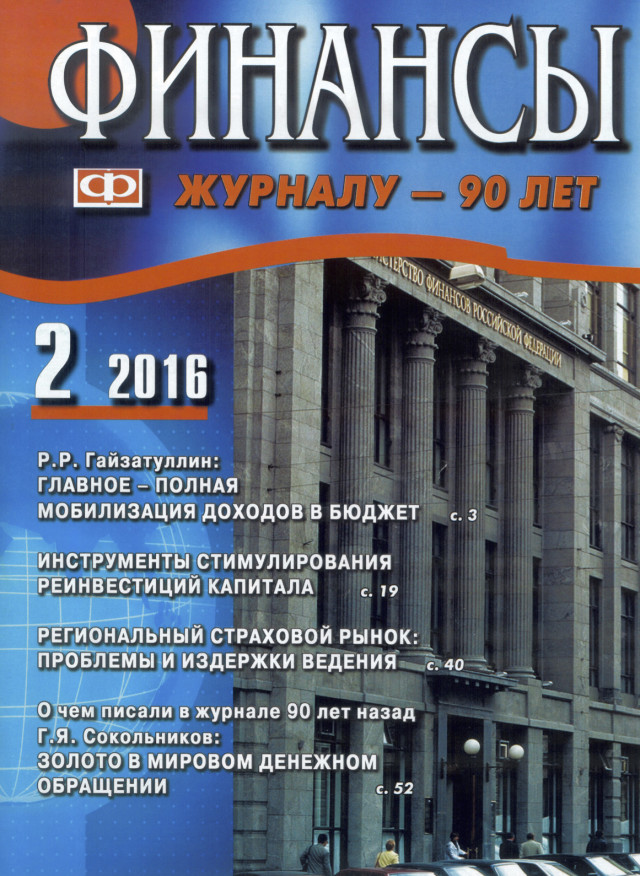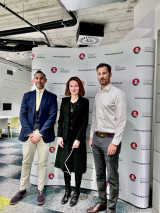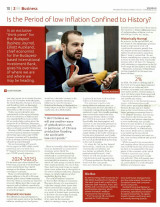International Investment Bank is 45
Source: Финансы
The International Investment Bank (IIB) was established in 1970 by Council for Mutual Economic Assistance (CMEA) member states to implement investment projects in these countries. The Agreement establishing IIB as an international financial institution was registered with the UN Secretariat under the number 11417.
IIB headquarters is located in Moscow. During the Soviet times, the IIB was the largest investment bank in CMEA member states, and many large facilities were built with its financial support. Since the beginning of its operations, the Bank took part in funding more than 200 facilities in various countries and disbursed more than €7 billion. Numerous enterprises in iron and non-ferrous industry, machine-building, electrical engineering and other industries were built thanks to IIB loans. The Bank was involved in funding joint construction of gas pipelines, motorways and railroads.
The collapse of the world Socialist system marked a new era in the history of the Bank’s development. German Democratic Republic, Hungary and Poland left the IIB. Czechoslovakia was split into two countries, both keeping their Bank membership; Hungary returned to the IIB in 2015. For today, 9 countries are members of the Bank: Bulgaria, Vietnam, Hungary, Cuba, Mongolia, Russia, Romania, Slovakia and Czech Republic. As IIB’s primary shareholder, Russia holds about 50% share of the paid-in authorized capital in the Bank.
Hungary’s return to the Bank after its withdrawal in 2000 due to stagnation in IIB operations is the most visible confirmation of the shareholders’ confidence in the Bank since its relaunch in late 2012.
The Bank represents 3 continents: Europe, Asia and Latin America. The Bank’s member states occupy 14.4% of the Earth’s territory, and account for 4.1% of the Earth’s population. This means the IIB has every chance to become a strong development bank in the future, connecting countries located on these continents.
Until 2011, IIB operations were impacted by uncertainty due to issues with old debts of some member states to the Bank, as well as attempted mergers with the International Bank for Economic Cooperation. However, due to differences in the shareholders’ positions on some major issues, the merger of these two banks was eventually deemed counterproductive.
Progressing from transitional economy to stable market economy growth, IIB member states face new challenges, related to increasing GDP along with radical improvements in the living standards, building a favorable environment for development of the people and society, providing long-term opportunities for social and economic development. These and other factors are considered when transforming IIB into a modern multilateral development bank.
An important step in the Bank’s further development was taken in June 2012, when the Council of the Bank approved IIB Development Strategy for 2013-2017, aligning the Bank’s mission, goals and objectives with the aspirations of the member states.
Now the Bank’s mission is to promote member states’ social and economic development and prosperity and to strengthen economic ties between them.
The Bank’s mission and goals shape key directions for transformation and primary objectives that will help the IIB to develop successfully and provide active assistance to sustainable development of its member states.
The Bank sees lending and investment activity as one of its most important strategic pillars. The IIB abandoned its old practice of case-by-case lending, gradually moving to new priorities of lending operations, such as taking part in syndicated loans and providing investment resources to international, regional and national financial institutions to support small- and medium-sized enterprises. The range of services and products provided has substantially increased, particularly in lending and investment areas.
For successful development of its lending operations, the Bank pays special attention to building up client base, which requires locating reliable borrowers and geographical diversification of the loan portfolio by boosting country-based approach and achieving a better correlation between a specific member state’s share in the Bank’s capital and the volume of loans allocated to it.
An important element in the IIB’s transformation was loan portfolio rehabilitation and toxic assets relief, which had prevented the Bank from acquiring an international long-term credit rating. The Board prepared a wide range of loan-portfolio rehabilitation measures, which was later approved by the Council of the Bank.
The Council authorized the Board to select the best options for reclaiming funds and to take action to implement the plan for what was considered ‘bad debts’; any non-performing loans remaining overdue as at 30 December 2013 were to be written off and 100% provisions were to be established. This way the Bank substantially streamlined its assets structure and balance, which facilitated IIB’s ‘re-launch’. The Bank has an efficient risk management system, taking into account intensive expansion of operations.
One of the main areas of IIB transformation into a modern development bank was its acquisition of global investment grade credit ratings. This simplified the financial borrowing procedure at the global capital market on more acceptable conditions, including by issuing and placing Eurobonds.
In 2014-2015, the Bank received international investment grade credit ratings: Fitch Ratings – Baa1 (outlook stable), Moody’s – ВВВ (outlook stable), Dagong Global, China – A (outlook stable). These ratings are currently the highest among all financial institutions based in Russia. Thanks to these high investment ratings, the IIB, for the first time in its history, gained access to stock market funding, being able to draw resources from the largest international financial structures, among others. In April 2014, the Bank issued ruble-denominated bonds worth RUB 2 billion in Moscow, followed by another issue worth RUB 4 billion in early December 2014; in October 2014, the IIB also debuted in Bratislava Exchange with Euro-nominated debentures by issuing five-year bonds worth €30 million. In the second half of 2015, the Bank successfully issued bonds in the Romanian Stock Exchange in that country’s currency. The Bank is seeing new opportunities in providing syndicated loans together with other international financial organizations.
In the near future, the Bank is planning to enter Chinese stock market. Expanded resource base allows the Bank to successfully implement its plans for growing new loan portfolio and expanding the product mix, as indicated in the Bank’s Development Strategy. Currently all its operations are aimed at maintaining investment grade credit ratings.
As part of Strategy Implementation, the IIB Board developed and approved Country Strategies taking into account member states’ national interests and their specific economic circumstances. In particular, when determining the most important aspects of IIB’s positioning in each member state, the Bank takes into account the development level of its financial system and the needs for investment in specific industries. This way, the Bank builds its activities around the interests of its member states and follows the principle of supporting their national economies.
decided to increase the Bank’s capitalization by €176 million, of which €76.0 million would come from retained earnings of previous years and €100.0 million from additional equity contributions. This way, the Bank’s paid-in authorized capital grew by more than 70% over the last 2 years. Most member states, excluding Czech Republic and Romania, have met their obligations to increase their share in the paid-in authorized capital. This gives IIB a much greater range of opportunities to grow balance total and activate lending operations.
To increase the Strategy’s efficiency and maintain control over its implementation, the Bank’s organizational structure and labor remuneration system were updated. The new organizational structure meets the latest international standards for a multilateral development bank. The core difference between the new organizational structure and the old one was the use of new principles of management and coordination between the bank’s divisions, which will receive the status of business units with specific area of activity defined for each one.
Another milestone in the Bank’s reform was Resolution No.101 of the Bank Council meeting of 8 May 2014 in Havana, Cuba, on amending the Agreement establishing the IIB and its Charter. All member states approved and signed the Protocol amending the Agreement Establishing the IIB; in the near future, once written consent has been obtained from all member states regarding completion of internal procedures for ratifying the Protocol, the Bank will apply the new statutory documents.
Their differences from the old ones, briefly, are as follows:
1. Goals and objectives have been redefined. As a multilateral development institution, the Bank sees its main goal in promoting economic growth, increasing competitiveness of national economies, expanding trading and economic ties and opportunities for cooperation in the investment sector for the benefit of member states. The Bank’s main objective is to finance and co-finance economically justified investment projects and programs operated by Bank’s member states and organizations.
2. Bank’s membership is open to not just countries, but also to any international financial organization, that shares the Bank’s goals and operating principles.
3. Subscribed capital has been increased, and the unpaid part of quotas distributed between the Bank’s members forms callable capital, which can be used to quickly increase funding of the Bank’s paid authorized capital.
4. Following the operating practices of international financial institutions, the Bank adopted a three-tier management system. The Bank’s managing bodies are the Board of Governors, the Board of Directors and the Management Board. The Board of Governors is the supreme collective managing body of the Bank. The Board of Directors is a collective managing body of the Bank responsible for overall management of the Bank’s operations.
5. The Bank decided to move away from the “one country – one vote” principle. From now on, when voting on decisions at the Board of Governors and Board of Directors, each Bank member is granted a number of votes proportional to that member’s share in the paid-in authorized capital of the Bank. Each member of the Board has one vote at Board meetings.
6. Upon individual agreements, the Bank can administer special funds created with interested countries and organizations’ resources to address tasks matching the Bank’s operating goals.
These and other changes in the Agreement Establishing the IIB create legal and economic grounds for its consistent transformation into a modern multilateral development bank.
The Bank’s operating results in 2014-2015 stand to show its new quality – that of a modern multilateral development institute, demonstrating the success of reforms and first results of the updated Development Strategy being put in action. The Bank’s financial status is becoming more sustainable compared to 2014, with balance structure improving. In 2015, the Bank saw more than a 30% growth in its assets. As of 31 December 2015, the Bank’s assets totalled €810.3 million.
The International Investment Bank is an open organization. Its membership is open to any country sharing the Bank’s goals and operating principles, and willing to accept obligations proceeding from the Agreement Establishing the Bank and its Charter. IIB membership does not affect the progress and development of member states’ financial and business relations with other member states, non-IIB countries and international financial organizations.
Source: "Finance" magazine


